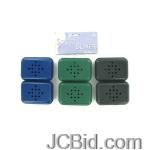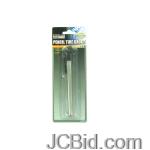
| Updated Blogs |
|
More .....
|
 RSS Feed | Login
RSS Feed | Login http://www.fr-batterie-portable.com
http://www.fr-batterie-portable.com/dell.html
Battery for Apple MacBook Pro 13
By Zdziarski at 2017-08-27 23:41:11
The Seagate blog says there is an Archive HDD inside the casing, which means it uses shingled magnetic recording, has six platters, reads and writes at 190/150MB/sec respectively, and spins at 5,900rpm. Obviously it is meant as a backup drive for notebook and desktop users.The drive has a natty shiny aluminium wrap-around, six-ribbed side look, one rib for each platter, with textured dark grey top and bottom surfaces. The thing can lay flat or be placed vertically. Its casing was designed by Huge-Design, a firm which has done product designs for GoPro, HP, and Nike.Customers get Seagate Dashboard software, with either one-click on-demand or customisable, scheduled backups, plus 200GB of Microsoft OneDrive cloud storage and Lyve software compatibility, so users can back up, access and share files from any device/location.The Innov8 drive will be available in April for $349 (US MSRP) through Seagate.com, Amazon and other resellers. Get a datasheet here, although it hardly tells you anything at all, just relatively useless guff like the box dimensions; there being nothing about shingled recording or the spin-speed, rendering it virtually useless. The FAQ is slightly more interesting.
Telecoms regulator Ofcom will not release details of its proposals for greater structural separation of Openreach and BT until the end of the year.In February the regulator stopped short of recommending a full separation of BT and Openreach in its Digital Communications Review.Ofcom will now draft its proposals for discussion between October and December, which will go before the European Commission to force the issue of greater independence.It said: We will develop detailed proposals to bring about greater independence and autonomy of Openreach for discussion with the European Commission, according to its Annual Plan for 2016/17.Ofcom will also publish plans to open access to BT's telegraph poles and ducts by competitors as part of its Wholesale Local Access market review, also due in the third quarter of the financial year.It said enhanced structural separation was needed as it had found evidence that Openreach still has an incentive to make decisions in the interests of BT, rather than BT’s competitors, which can lead to competition problems.
In a briefing following the publication of its once-in-a-decade review, Ofcom's group director Steve Unger said that in an ideal world the regulator would have recommended a formal separation of the businesses, due to the significant failings of the current model. However, the property and pension costs associated with that option led the regulator to reccomend a “formal separation in everything but name” approach.Ofcom chief Sharon White insisted that formal separation would remain an option for the regulator.When we describe this as an option over which we reserve the right, that is genuinely the case. It is not there in the background because we forgot to take it off the table.Jonathan Oxley, group director for competition at Ofcom, said BT had submitted voluntary proposals for reform but they didn't cut the mustard.Also speaking after the publication of the review, Mark Shurmer, BT's group director of regulatory affairs, said BT hoped it could still reach a voluntary agreement with Ofcom.He said: The alternative to a voluntary separation is that we would have to go to Brussels. That will be a long process, so it would be in everyone’s interest [to avoid that route].
- Battery for Apple PowerBook G4 17inch
- Battery for Apple PowerBook G4 15inch Titanium
- Battery for Apple PowerBook G4 15 A1106
- Battery for Apple MacBook Unibody 13
- Battery for Apple MacBook Pro Unibody 15
- Battery for Apple Macbook Pro 17 A1151
- Battery for Apple MacBook Pro 15 A1286 (Mid-2010)
- Battery for Apple MacBook Pro 15 A1286(2011&2012 Version)
- Battery for Apple MacBook Pro 15 A1286 (2009 Version)
- Battery for Apple MacBook Pro 15 A1286 (2008 Version)
- Battery for Apple MacBook Pro 13inch Precision Aluminum Unibody 2009-2010
The US Consumer Product Safety Commission (CPSC) says that the recalled battery packs - built by Panasonic - were shipped in 91,000 notebooks in the US and 10,000 in Canada between June 2011 and January 2016.The recalled batteries power Toshiba Satellite, Portégé and Tecra models and were sold through Staples, Office Depot and the toshibadirect.com website.The CPSC notes that some of the now-recalled packs were also sold individually or as repair kit by Toshiba.While Toshiba's website calls the recall voluntary, the CPSC is advising that consumers immediately check their notebooks and, if using a recalled battery, remove the unit and use AC power until a replacement is delivered.The CPSC said that it has received four reports of the batteries overheating and melting, though no injuries were reported.This is far from the first time notebook batteries have been recalled. The lithium-ion power packs are notoriously prone to overheating and catching fire when damaged, or due to manufacturing defects.Such recalls have in the past forced PC sellers to call back millions of notebooks from their owners and added up to cost component vendors hundreds of millions of dollars.
Some 1.5 million Verizon Enterprise customer records have been stolen and are being sold on a criminal hacking forum, according to reports.A trusted seller on a popular but shadowy unnamed criminal forum asked for US$100,000 for the database or US$10,000 for batches of 100,000 records, investigative blogger Brian Krebs reports.Verizon Enterprise counts 99 percent of the Fortune 500 among its customer base.Verizon told Krebs it had found and fixed a vulnerability in its enterprise client portal and is contacting customers.“Our investigation to date found an attacker obtained basic contact information on a number of our enterprise customers. No customer proprietary network information or other data was accessed or accessible,” the company says.The unnamed seller is also reportedly selling vulnerabilities in the Verizon website. Buyers will receive the stolen databases in MongoDB format.The information will be useful in crafting personalised, and therefore more enticing, phishing messages, which is a crucial first step in many attacks against enterprises. The idea is to simplify what Docker's developer relations director Mano Marks says (video below) is a “dependency hell” created by the multi-layer installation currently required – installing Docker Toolbox, then installing Docker Machine, and then configuring a suitable VM (like VirtualBox on OS X).Announced just before Easter, the Windows and Mac OS beta offerings are designed to let devs get a taste for Docker on the desktop or laptop, without having to run up a server implementation.For OS X users, the Docker engine runs in an Alpine Linux disto, using the xhyve Virtual Machine. Windows users can run it up on Hyper-V and use Docker to manage the virtual machine.
- Battery for Apple MacBook Pro 13
- Battery for Apple MacBook Air Core i7 13 (Mid-2013)
- Battery for Apple MacBook Air Core i5 13 (Mid-2013)
- Battery for Apple MacBook Air 13.3-inch
- Battery for Apple Macbook Air 13.3 A1496 (2013 Version)
- Battery for Apple Macbook Air 13.3 A1466 (2013 Version)
- Battery for Apple MacBook Air 11 A1465 (2013 Version)
- Battery for Apple Macbook Air 11 A1465 (2012 Version)
- Battery for Apple iBook G4 14inch
- Battery for Apple iBook G3 14inch
- Battery for Apple iBook G3 12inch
- www.all-laptopbattery.com
“All you need is Docker, git, and a text editor or whatever version control system and IDE you want to use,” Marks says in the video.The native applications have a native user interface, auto-update, and a bunch of bundled tools: Docker command line, Docker Compose, and Docker Notary command line.DNS servers and networking integration for OS X and Windows, to make it easier to access containers over the LAN;
In Mac environments, the native release is designed to work with the OS X sandbox security model: “we are working closely with Apple to achieve this”, the announcement notes.
Marks also notes that “you can develop apps on your machine without having the runtime or framework installed on your machine”.For Mac, the minimum requirement is OS X 10.10.3 (Yosemite) or above running on a 2010 or later machine with Intel support for memory management unit (MMU) like extended page tables. Windows users need a recent Windows 10 Pro and Hyper-V.Amazon Web Services (AWS) released WorkSpaces, Windows desktop-as-a-service, towards the end of March 2014.We took an early look, but encountered several niggling problems. Don't dive in: it will get better, was my conclusion.It is time for another hands-on, but first a quick recap. WorkSpaces provides a Windows desktop on Amazon's cloud. There are three specification levels:In addition, you can pay $15.00 extra per month for Microsoft Office Professional, or you can save $4.00 if you bring your own Windows 7 desktop license. There are clients for Mac, Windows, iOS, Android and Chromebook; other operating systems such as Windows Phone and Linux are not supported. Standard Windows RDP clients are not supported.
Permalink | Comments (0)
Comments
To add a comment please login by clicking here




